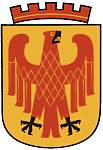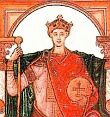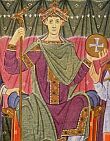
Für eine deutsche Übersetzung dieser Seite einfach die Brandenburger Flagge anklicken
 |
Click the Brandenburg Flag for a German translation Für eine deutsche Übersetzung dieser Seite einfach die Brandenburger Flagge anklicken |


 |
Home Towns - Potsdam, GermanyPotsdam's Rulers throughout the Centuries928-1157 |
 |


 |
This site is part of our Potdam, Germany site. Click the left turn sign to get back to the Potsdam start site. |


 History is not made by individuals, but by people. However, the history made by the people is often associated with the rulers of the time. Here is a list of those who took credit and blame for Potsdam's history. We are not trying to compete with Wikipedia's comprehensive list of Rulers of Brandenburg although we have been trying to fill in some blanks here and there. Biographical references are generally limited to events affecting Potsdam and/or Brandenburg. The dates under the names don't refer to birth and death but rather to the time in office. Blue links lead to sites with more information, in most cases to a Wikipedia article. In some cases, we couldn't find an article in English language; in this case, Green links lead to articles in German language. |

 |
This is Part 1 of our Potsdam's Rulers Through the Centuries site, covering the years 890 through 1157. If you are interested in a different time period, click the U-turn sign to get to the "Rulers" start page. |


 
|
Drahomíra of Stodor 890 - 928  Since the 600s, Slavonic people, more precisely a Wendish tribe, the Hevelli, had settled along river Havel and built a permanent stronghold at a passage across the river. The Hevelli were most likely ruled by a noble family but their names have faded in the dust of ancient history. The name of Princess Drahomíra (born around 890) survived, because she was the wife of the Bohemian Duke Vratislav I and the mother of Saint Wenceslaus, patron-saint of the Czech nation. Drahomíra adhered to the old, so called "pagan" believes of the Slavonic people and became famous for the assassination of her Christian mother in law, Saint Ludmila. Drahomíra, though Hevelli and most likely born in Brandenburg moved to Bohemia after her husband's death in 921. The power vacuum created by that move certainly helped, when the Ottonians took over the land that was later to become Brandenburg.
|

|
 
|
Henry I 928 - 936  In 927, East Francian King Henry the Fowler, who is often considered to be the first German King, expanded his realm further east beyond river Elbe.  In 928, he conquered the Hevelli and took their stronghold Brendanburg (now Brandenburg/Havel). A year later, he put down a rebellion in Bohemia, and in 932 he crushed an uprising of the Veleti Obotrites, two Slavonic tribes living north of the Hevelli. in 933, he stopped the advance of the Hungarians into Germanic territory and in 934, he defeated the Ukrani and the Lusitzi. |
  Wikipedia Biography
Wikipedia Biography
|
 There are a lot of conflicting records about Henry's life and his place in history and over the last 1,000 years, pretty much every political movement in Germany tried to make him their own. But only a few written records have survived and most we know about Henry originates in oral history that is most likely skewed in his favor. However, he definitely deserves credit for uniting the German tribes in one nation, 80 years after the division of the Carolingian Empire.
|
 
|
Otto I 936 - 937  Otto I, son of Henry I was born in 912. He became East-Francian King after his father's death in 936. More concerned with the southern part of the kingdom than with the land his father had conquered in the north, he consolidated those areas into a county called the Eastern March, and appointed Saxon chieftain Gero as margrave. However, as King he still left his mark in the land that was later to become Brandenburg. In 946 and 948 respectively, he founded the Bishoprics of Havelberg and Brandenburg, thus pushing the Christianization of the Slavonic natives. |
  Wikipedia Biography
Wikipedia Biography
|
 In 961, Otto I passed the East-Francian crown on to his son and in 962, he was elected Emperor of the Holy Roman Empire of the German Nation. Otto I distinguished himself in the consolidation of the Empire and started a time of cultural prosperity, later called the Ottonian Renaissance. He died in 973 and is buried in Magdeburg.
|
 
|
Margrave Gero 937 - 965  Gero was born in Merseburg at around 900. In 937, Otto I enfeoffed him with the Eastern March. Otto I ordered his governor to fight off the Wendish nations native to the area and Gero was a ruthless ruler. He fought off a number of Wendish uprisings, and when chivalrous fighting wasn't good enough anymore, he invited thirty Slawonic noblemen to a banquet and had them assassinated in his own castle.  Shortly before he died, in 962/963 he won a battle with Polish Prince Mieszko I who was forced to acknowledge German rule in the area - at least for a while.  Gero died in 965 after a pilgrimage to Rome and is buried in Gernrode.
|

|
 
|
Dietrich of Haldensleben 965 - 983  After Gero's death in 965, the Eastern March was divided into five smaller entities. One of them, the Northern March can be considered the predecessor of Brandenburg. First Margrave was Dietrich of Haldensleben, of whom we know only little. We don't even have an authentic picture - the photo to the right shows the Roland statue in front of the Haldensleben town hall.  Dietrich was a successful military leader in Otto I's battle for succession; and Otto thanked him by feoffing him with the Northern March. As ruler of the land, his fortune changed. He rules with an iron fist, which eventually provoked the Great Slavonic Uprising of 983, after which the young German Empire lost control over the area for almost 200 years. Dietrich died two years after the uprising.
|

|
 
|
Mieszko I 983  At the same time, Polan Prince Mieszko I built the foundation of a Polish state east of the German border. In 963, Mieszko tried to extend his realm westward across River Oder, but was defeated by Margrave Gero.  978, after the death of his first wife, Mieszko tried a different way to gain power in the Northern March. He abducted Oda, daughter of Margrave Dietrich from a monastery and then married her. With that, he could have been the next Margrave of the Northern March, but the Great Slavonic Uprising only five years later put an end to these dreams.
|

|
 
|
Otto II 961 - 983  Otto II, born in 995, first co-reigned with his father. He was chosen German king in 961, and was crowned emperor of the Holy Roman Empire in 967. He conquered large parts of Italy, but lost what is now Brandenburg to the Hevelli in 983.  Otto II died the same year in Rome, leaving the empire in the hands of his then three year-old son. |
 Wikipedia Biography
Wikipedia Biography
|
 
|
Otto III 993  Otto III, born in 980 was only three years old, when his father died. He was acclaimed King of Germany shortly before his father's death, but ruled under the guardianship of his grandmother Adelheid, widow of Otto I, until he came of age. While the empire was fairly consolidated in the west and in the south, Slavonic tribes constantly challenged German authority east of the Elbe and Otto III never really ruled this part of his empire.  Otto III's move in 993 to hand "his" properties in and around Potsdam over to the Quedlinburg Abbey was mainly an attempt to stem back Slavonic influence in the area. His deed of 993 was the first documented mentioning of the name Potsdam (Potztupimi).
|
 Wikipedia Biography
Wikipedia Biography
 The Potsdam Deed of 993
|

 
|
983 - 1150 The Return of the Hevelli  One more time, for 167 years, the Wendish were rulers of their own land. Starting in 985, German emperors as well as Polish Kings raided the Slavonic people of the March on an annual basis, culminating in the Wendish Crusade of 1147. however, between 983 and 1128, no Ruler, German or Polish could really claim the March as his own. The names of the "pagan" Wendish Rulers are lost in history. Records only start again around 1100, when Hevelli Prince Meinfried converted to Christianity. He was the first Wendish Nobleman to do so.
|

|
Here is a list of the
German Emperors and
Polish Kings of the time with links to their respective
Wikipedia biographies. Chances are that, at one time or another, they all claimed possession of the land between rivers Elbe and Oder.
|

 |
Henry II 1014-1024 |
 |
Conrad II 1027-1039 |
 |
Henry III 1014-1024 |
 |
Henry IV 1084-1105 |

| ||
|
Henry V 1111-1125 |
 |
Lothair III 1133-1137 |
 |
Conrad III 1138-1152 |
 |
Barbarossa 1152-1190 |
 |




In 1002, Polish King Boleslaw I tried to conquer the March, in return, in 1005 German King Henry II attacked Poland. In 1007, Polish troops made
it all the way to River Elbe near Magdeburg. In 1013, both sides came to a temporary settlement, but already in 1015, Henry II attacked again. He
failed and lost Lower Lusatia. As a result, the Slavonic natives of the area,
the Veleti, turned against Germany and completely ransacked the
Bishoprics of Havelberg,
Brandenburg, and
Oldenburg.
 In 1031, the tide turned in German favor. German King Conrad II defeated Polish King Mieszko II and regained much of the territory lost in 1015. However, the native Slavonic nations keep fighting and in 1056, the Veleti defeated the Saxons, killing Margrave William. 12 Years later, in 1068, German King Henry IV charged the Veleti, but retreated the following year. All the while, German emperors kept appointing Margraves to the Northern March, if only to underline their claim on the area. Those Margraves were mostly rulers without land, but history remembers their names - though not much more than that. Here is a list of the Princes who called themselves Margraves of the Northern March, while the land was actually ruled by its native sons for most of the time. |

 
|
House of Walbeck
 1985 - Lothair of Walbeck 1003 - Werner of Walbeck 1009 - Bernhard I 1018 - Bernhard II 1044 - William of Walbeck |
 
|
House of Stade
 1056 - Lothair Udo I 1057 - Lothair Udo II 1082 - Henry the Long 1087 - Lothair Udo III 1106 - Rudolph I |
 
|
House of Stade
 1114 - Henry II 1128 - Udo IV 1130 - Rudolph II | ||
 
|
House of Plötzkau
 1112 - Helferich von Plötzkau |
 
|
House of Plötzkau
 1130 - Konrad von Plötzkau |

In 1100, Margrave Udo III lead a successful campaign against the Slavonic nations east of river Elbe and conquered the stronghold Brandenburg.
This could have lead to a consolidation of German rule, but Udo III died just six years later during a meeting with Saxon princes. Most likely
he was poisoned. Now, that Polish and Slavonic resistance was dwindling, the German princes engaged in one of Germany's worst traditions:
fighting each other.
 In 1115, German King Henry V was decisively weakened by an uprising of Saxon and Thuringian Princes. Amongst the Saxons was one Prince who was about to make a name for himself: Albert of Ballenstedt, who was later called Albert the Bear. In 1124, he conquered Lower Lusatia and in 1127 supported Christian Hevelli Prince Pribislav in his quest for leadership of the Hevelli. In return, At the babtism of Pribislav Albert's son Otto, Pribislav presented the little Saxon Prince with a piece of Land along rivers Havel and Nuthe, called Zauche. a year later, after the death of Margrave Henry II, Albert officially claimed the title, but the King ignored Albert's claim and appointed Udo of Freckleben (Udo IV). but Albert wasn't to be ignored and without further ado slayed Udo in 1230. However, it took another four years until King Lothair III made Albert's claim official. In 1134, Albert was officially enfeoffed with the Northern March. In 1142, Albert conquered the Havelland Region, in 1147, he added the Prignitz and Ruppin Regions. After the Wendish Crusade of 1147, only two tiny Wendish nations remained under native rule: the Christianized Hevelli, and the "pagan" Sprewani. |


 
|
Pribislav 1127-1150  Hevelli Prince Pribislav was born in 1075. He was the son of Meinfried, the first Christian ruler of the Hevelli. Over the years, Pribislav developed a close friendship with his Saxon neighbor Albert the Bear. With Albert's assistance, Pribislav became Ruler of the Northern March in 1127. In the same year, he was the godfather of Albert's first son Otto. In 1134, German Emperor Lothair III crowned Pribislav King of the Hevelli.  During the Wendish Crusade of 1147, Pribislav's Christian denomination and his friendship with Albert saved the Hevelli from the atrocities other Slavonic tribes had to endure. Albert used the Northern March as staging area for his crusade, but while the northern Slavonic tribes were brutally "converted," the shift of power in the Northern March happened peacefully. Childless Pribislav wanted to ensure continuous Christian rule of his land and made Albert his universal heir.  Pribislav died in 1150, and the peaceful coexistence of Wendish and Germanic people during his reign was the cornerstone of a multicultural tradition that has been Brandenburg's most noble virtue for almost 1,000 years.
|

|
 
|
Albert the Bear 1150-1170  Albert was born around 1100 as son of Ascanian Count Otto the Rich. In 1132/33, he participated in the Italian Campaign of German Emperor Lothair. In return, he was enfeoffed with the Northern March. At this time, Albert already had developed ties with Hevelli King Pribislav. In 1150, after Pribislav's death, he inherited the land of the Hevelli. But before he could really call himself ruler of the Northern March, he had to face one last challenge.
|

|
 
|
Jacza de Copnic 1157  After Pribislav was crowned King, the land along rivers Havel and Nuthe practically became part of the German Empire. The eastern border of the Empire, formed by the two rivers, separated two Wendish nations - the Hevelli under their Christian king Pribislav and the Sprewani under "pagan" prince Jacza. After Pribislav's death, Jacza claimed the land of the Hevelli. Opposite to their Christian king, most ordinary Hevelli still adhered to traditional Slavonic believes and therefore supported Jacza's claim.  In Spring of 1157, pulling all registers of treason, bribe, deceit and force, Jacza conquered the Hevelli's main fortress, Brandenburg and with that, de-facto ruled the Northern March. But his victory was short-lived. On June 11, 1157, Albert the Bear defeated Jacza in a bloody battle. In a document dated Oct. 3, 1157, Albert first claimed the title Margrave of Brandenburg (Adelbertus Die gratia marchio in Brandenborch).  |

|
 |
Ever since, the date of Jacza's defeat, June 11, 1157, has been celebrated as the birthday of the Brandenburg Margraviate. |


|
The House of Ascania 1150-1320  For the next seven generations - over 170 years - the Brandenburg Margraviate was ruled by the House of Ascania. The original home of the Ascanians was Saxony - their name derived from Ascharia, Latin name of the town of Aschersleben, which had been their residence since about the year 1000. But their Brandenburg-Line was soon considered native to the Margraviate. Under the Ascanians, Brandenburg experienced a period of growth an wealth.  Most famous members of their family were Brandenburg's first Margrave Albert the Bear and his grand-grandsons, brothers Johann I and Otto III, who brotherly shared the throne and turned Brandenburg into one of the most important German principalities. |
 |
Click the right-turn sign to continue to Part 2 of our
Potsdam's Rulers Through the Centuries site, covering the House of Ascania,(1157-1320). |

|


 Back to Potsdam Page |
 Back to Home Towns |
 Back to Germany Page |
 Back to English Main Page |
 Back to Start Page |